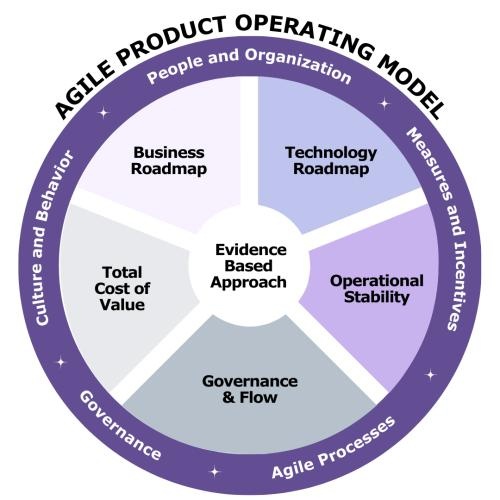Since the launch of the Government Digital Service over a decade ago, the UK government has made significant strides in modernising delivery. Standards such as the Government Service Standard and frameworks like the Digital, Data and Technology (DDaT) Playbook have encouraged iterative delivery, multidisciplinary teams, and user-centred design – all great things. Unfortunately, it’s 2025, and how many new work packages do you still see with fixed deadlines, fixed scopes, and no assessment of whether the solution addresses the problem? Too many, because we are still have an output-valuing culture.

An Agile Product Operating Model (APOM) offers a more enduring approach. It replaces temporary structures with stable, outcome-driven product teams that are funded, measured, and governed differently. Applied within UK Government, an APOM could create the conditions for agility at scale and not just in pockets of excellence i.e. across departments and agencies.
What an Agile Product Operating Model Looks Like
In an APOM, teams are organised around products and services, not projects. Imagine funding flowing to product lines such as "Digital Case Management" or "Border Security Analytics," rather than to temporary initiatives with start and end dates, funded by resources (I sometimes call that body-shopping). Teams are multidisciplinary and stable, combining policy experts, engineers, designers, and commercial professionals. Crucially, they are accountable for outcomes, not outputs. The problem right now is that Government believe they are buying flexibility, but they are actually buying a bum on a seat – so let’s shift towards outcome based operating models! This idea aligns closely with lessons from Scrum.org’s evidence-based research, which shows that transformations stall when they focus only on frameworks and events rather than structural change³.
At Optilearn we have an entirely free, half-day Evidence-Based Management Masterclass that supports this research – what’s stopping you from asking us to run it for you?
Why the Government Needs It
Government is under pressure to deliver more for less; the same as everywhere, really. The Cabinet Office has set targets for SME participation in procurement at 33% of spend, though in 2024 it remained closer to 20 percent⁴. At the same time, the DDaT workforce is stretched, with departments competing for scarce skills. The prevailing project-based model makes these challenges worse by wasting talent through constant reshuffling and creating fragile delivery pipelines – and I can personally tell you that’s true, because I’ve worked in those pipelines!
An Agile Product Operating Model offers a structural response instead of a tactical one. Stable, long-lived teams improve efficiency by reducing start-up and handover costs, while also making better use of supplier capacity. Resilience grows as teams build institutional knowledge, making them less vulnerable to attrition or turnover. Clear product leadership creates accountability, with success measured against outcomes such as citizen satisfaction or reductions in case processing times. Crucially, suppliers can be integrated more effectively within this structure. SMEs, for example, can embed directly into product teams, bringing in specialised expertise when needed without the disruption of continual re-procurement. This makes the supplier relationship less transactional and more collaborative, ensuring that external capability strengthens, rather than fragments, delivery.
Applying APOM to UK Government
To implement an APOM, the UK would need to address several systemic blockers and adopt both tactical and strategic measures. Here are my ideas for early wins with potential longer-term reforms below.
Small initial steps:
- Pilot product teams in priority areas: Begin with services where user demand is high and pain points are well known, such as procurement – I’ve never met anyone who thought procurement was efficient. Establish two or three cross-functional product teams to identify the problem-fit before thinking about solution-fit.
- Adapt funding within existing envelopes: Use discretionary budgets or innovation funds to experiment with product-based funding, avoiding the need for policy reform.
- Update assurance on a pilot basis: Allow selected programmes to undergo outcome-focused assessments rather than artefact-heavy reviews, testing a lighter governance model in practice.
Medium-term measures:
- Extend product-based funding: Work with HM Treasury to reframe business cases around outcomes, enabling budgets to flow to enduring product lines instead of projects.
- Formalise governance reforms: Scale up outcome-based service assessments across GDS and Cabinet Office, supported by clear guidance and training for assurance leads.
- Develop product leadership capability: Invest in training and recruitment to ensure that each product line has a recognised leader with authority over priorities, trade-offs, and value measurement.
Long-term reforms:
- Embed product thinking in fiscal policy: Shift HM Treasury’s budgeting model toward multi-year, rolling funding for product lines, mirroring practices in other sectors – 12-month portfolio reviews aren’t working.
- Reform procurement frameworks: Adapt DOS, G‑Cloud, and CCS frameworks to enable modular contracts and multi-year supplier integration, so SMEs can contribute sustainably to product teams.
- Institutionalise outcome metrics: Align departmental scorecards to evidence-based measures of value such as citizen satisfaction, time to market, and ability to innovate.
- Reshape governance culture: Encourage a shift in senior leadership expectations from milestone delivery to outcome stewardship, reinforced through performance objectives and accountability structures.
By sequencing these actions, the Government can demonstrate quick wins while laying the groundwork for systemic change. The tactical pilots prove feasibility, medium-term measures create organisational momentum, and long-term reforms embed APOM as the default operating model for public service delivery.
What Can You Do About It Today?
One of the most practical ways to bring the Agile Product Operating Model to life is through a self-diagnosis assessment; and I’ve worked very hard. This audit gives organisations a structured way to examine how well their strategy, people, structures, value cycles, and enabling capabilities are really working together. Rather than relying on opinion or aspiration, it anchors the conversation in evidence: how decisions are made, how value flows, and how teams are empowered. The output is a clear picture of maturity across the four pillars and a fifth, enabling one, highlighting both strengths to build on and constraints that hold progress back.
